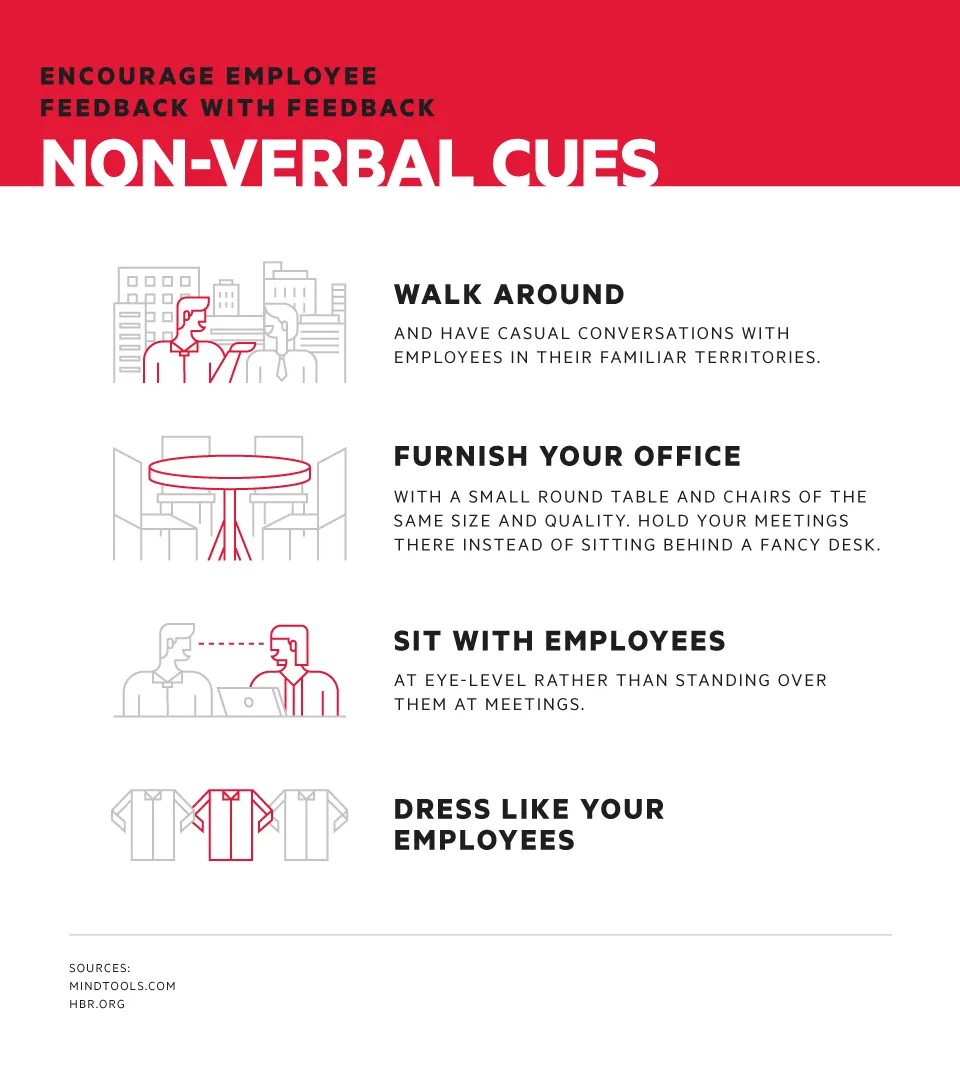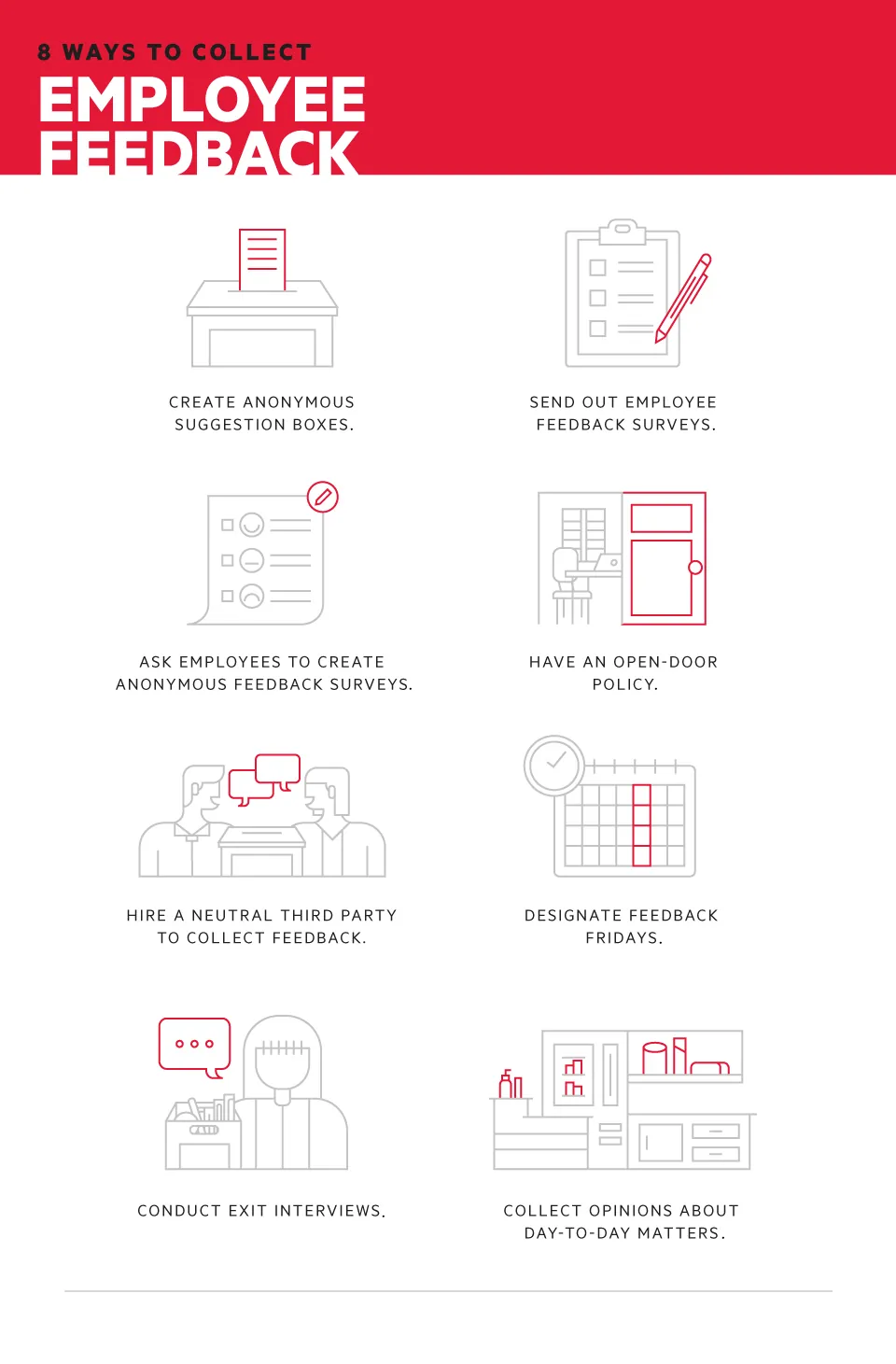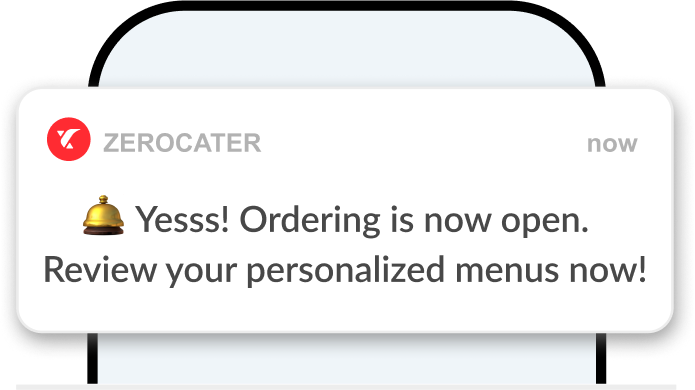Regularly collecting employee feedback can enhance your office culture, boost morale, increase productivity, and even improve your team members’ health and well-being (if you survey them about your company’s food program).
In spite of these and other benefits, many organizations fail to solicit employee feedback or act on feedback in constructive ways. In fact, only one in four employees strongly agree their company takes employee feedback and suggestions seriously, according to a TINYpulse survey.
Many managers want to do better. Nearly two-thirds (61%) of managers wish they knew the sentiment of their team better. The good news? Collecting employee feedback is a skill you can learn, practice, and refine. Let’s take a closer look at why you should gather employee feedback, some of the best ways to obtain it, and how to use it to build a better culture and food program at your office.
The Benefits of Collecting Employee Feedback in the Office
Poor management is one of the primary reasons employees quit their jobs. By being more responsive, your company may be able to reduce turnover (thereby reducing expenses) and improve employee morale.
What do your employees want? The only way to know is to ask. Employee feedback enables you to understand team members’ experiences, identify challenges and potential solutions, and collaborate with employees to create a healthier, happier workplace.
When you find out what your employees value and act on their feedback, you show your employees you care about them. They feel more acknowledged and understood, and they may in turn be more motivated at work. Employees who feel listened to are 4.6 times more likely to feel empowered to do their best work, according to a study of 1,500 business professionals.
Two-way dialogue between managers and employees is essential in today’s modern workplaces, which are less hierarchical than institutions of the past. Ongoing conversations help teams and managers problem-solve together, strengthen relationships, maintain employee engagement, and boost productivity. Plus, younger generations favor frequent, two-way feedback.
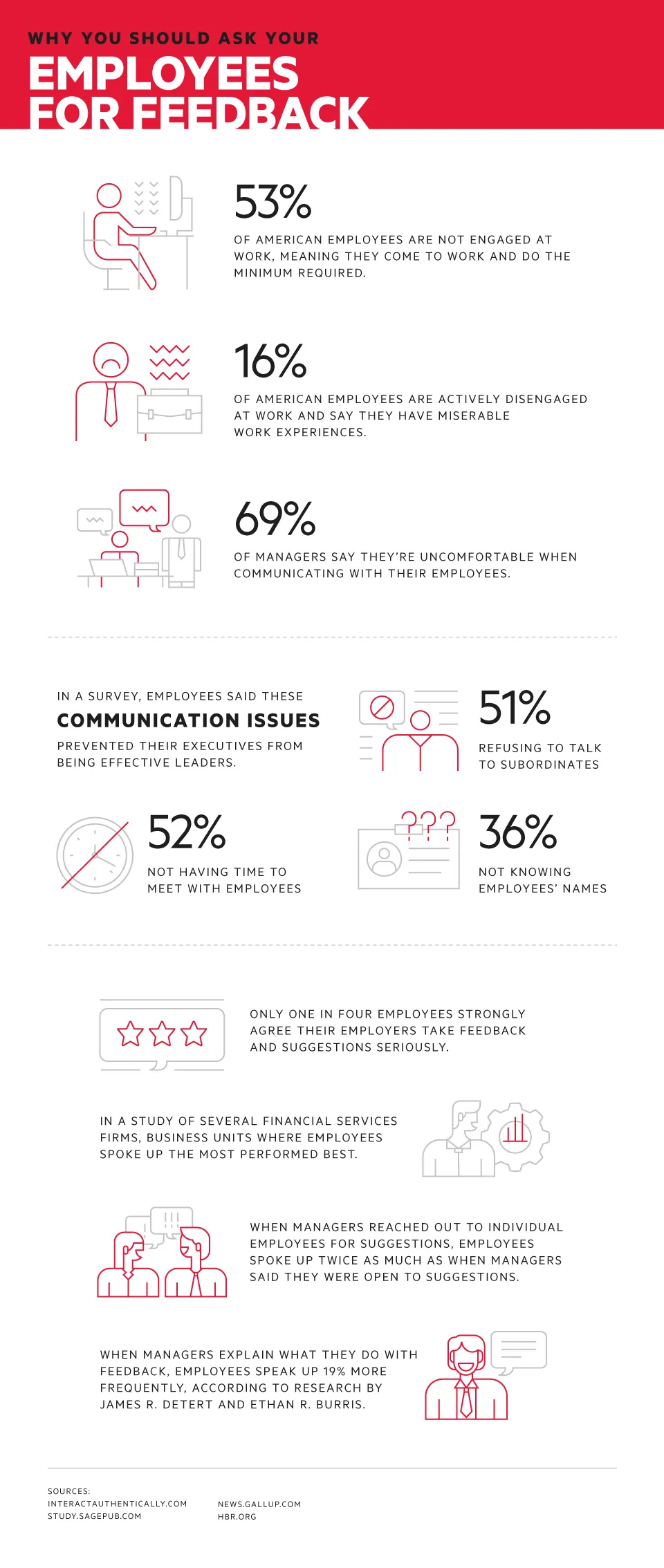
Ready to get better at collecting feedback? Read on to learn some of the best ways to collect feedback from your employees.
The Best Ways to Collect Feedback From Employees
Here are some ways to encourage your employees to speak up about their concerns:
- Create anonymous suggestion boxes
This strategy is classic for a reason. Anonymity may encourage honesty, particularly if employees have strong concerns or criticisms. It’s as easy as it sounds to create a suggestion box. Leave blank sheets of paper next to an empty box. Also, consider creating an anonymous online suggestion box for greater convenience (and so employees don’t worry about managers matching handwriting to them). This option also allows remote workers to suggest improvements. - Send out employee feedback surveys
Actively solicit employee feedback on a monthly or even weekly basis to show your employees that your management team cares what they think. Make the surveys anonymous so employees feel safe to speak freely.As part of these surveys, consider asking employees to share their top three challenges. This method allows you to identify issues and take prompt action to make employees’ workloads more manageable.Another helpful question? Ask employees to envision their ideal workplace. Managers risk getting stuck in the mode of putting out fires instead of building a healthier workplace for all. Take team members’ ideas seriously and use reasonable steps to create a workplace that resembles the collective’s vision.
- Ask employees to create anonymous feedback surveys
Survey questions dictate employees’ responses, and they may not paint the whole picture. For example, if you consistently ask employees about certain aspects of their workplace but not others, you may deny them the chance to share valuable feedback.For this reason, consider asking employees to design feedback surveys themselves. This way, they can tailor questions about the issues they deem most important. - Have an open-door policy
Not all employees are comfortable sharing constructive feedback in person, but an open-door policy sets a receptive, collaborative tone in the workplace — and that’s reason enough to have one. Let employees know they’re welcome to share concerns, feedback, and questions with management at any time.Just as important? Train every member of the management team to respond to feedback with receptivity and transparency. Teach managers not to respond with defensiveness, aggression, or punitive action. And encourage managers to express interest in their employees’ lives, which will encourage more honest feedback. - Designate Feedback Fridays
Designate every Friday as a Feedback Friday, and you’ll bake open dialogue into your company culture.
On Fridays, schedule individual check-ins with each team member or host a lunchtime roundtable where you encourage team members to talk through questions and concerns. - Hire a neutral third party to collect feedback
No matter how open your management team is to employee input, some team members may have concerns about sharing feedback directly and honestly. You may want to hire a neutral third party to collect input, especially if your company is going through a crisis or transition. A buffer between employees and management helps protect employee anonymity and may make feedback more palatable to upper-level staff. - Conduct exit interviews
With any luck, regularly collecting and constructively responding to employee feedback will help reduce employee turnover — so hopefully, you won’t conduct many exit interviews. But be sure to schedule a one-on-one conversation whenever an employee gives notice. Exit interviews help you learn whether an aspect of the workplace is contributing to employee turnover so you can address issues promptly. - Collect opinions about day-to-day matters
Amidst personnel issues and equipment needs, it’s easy to overlook asking for feedback about day-to-day workplace factors, such as your company’s food program. But all facets of an employee’s work experience impacts morale and well-being. If you have a food program, consider working with a provider that collects and analyzes employee feedback to consistently improve their offerings. Make sure they ask for your team’s opinions about:- The food and drink options offered daily
- The food and drink options available during team lunches
- Whether they feel like you accommodate their dietary restrictions or preferences
- Whether they feel like you respect their cultural food practices

How to Use Feedback to Build a Better Food Program
To encourage your employees to speak up more, you must take action on their suggestions. Are you unsure how to act on the feedback you’ve collected? When it comes to your company’s food program, here are proven strategies to use feedback to improve offerings.
- Expand what you serve
Ask your employees what they love to eat and add those dishes to your offerings. Research suggests the most responsive organizations present their employees with an array of food choices. If you always order from the same restaurant or serve the same types of cuisine, you may unwittingly exclude certain employees from participating in food-based gatherings. Rotate through a wide variety of restaurants and cuisines to ensure everyone is included at least some of the time. - Better accommodate dietary restrictions and preferences
More than a third of Americans follow a special diet, so the odds are high that some members of your workplace do. Poll employees about their dietary restrictions and preferences to ensure your offerings are inclusive. Include vegetarian, vegan, dairy-free, and gluten-free options at team meals. - Incorporate more healthy options
Healthy food provides sustainable energy, enhances alertness, and improves physical and mental health, which may help reduce employee absenteeism, among other benefits. Plus, many workers crave healthier food options at work. Offer your employees a range of healthy snacks and meals that contribute to their productivity and overall well-being. But don’t feel like it’s your company’s job to regulate team members’ food choices. Make healthy options available and allow employees to make their own food choices.
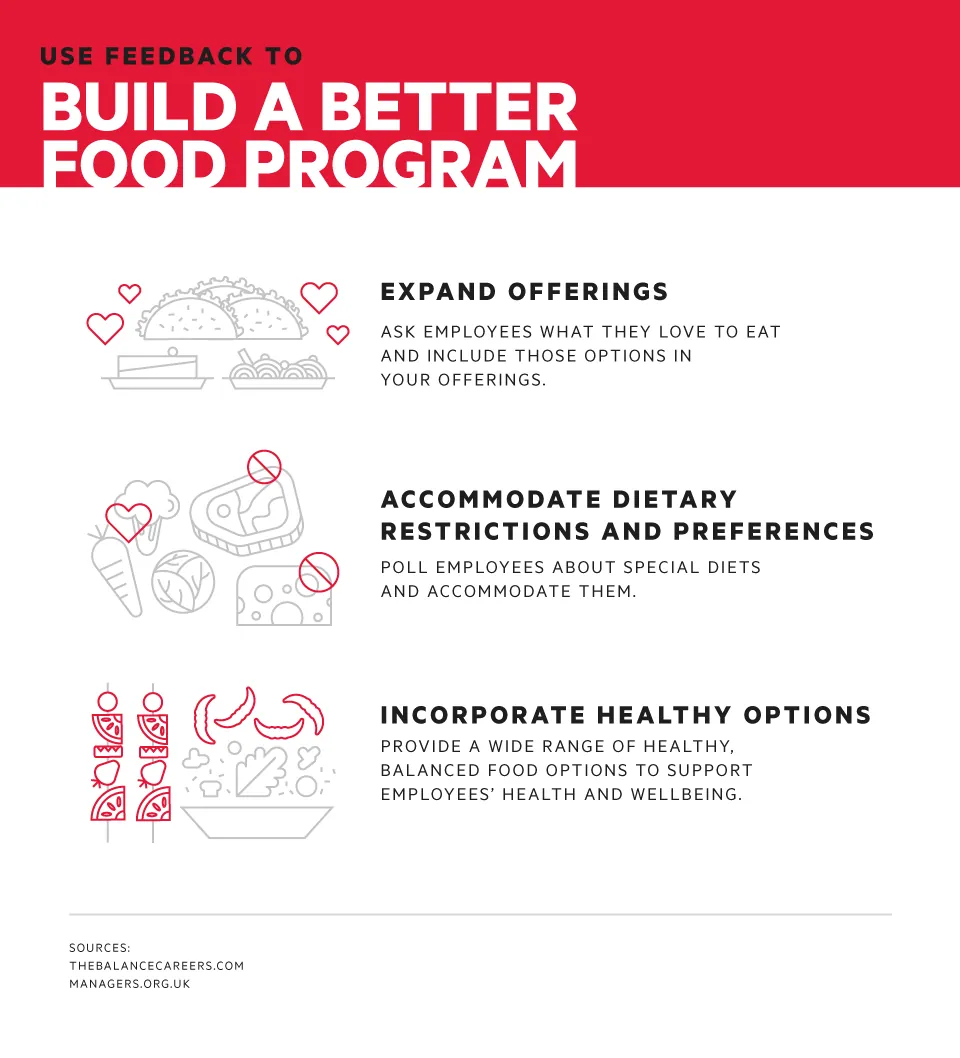
Conclusion
You can use employee feedback to improve virtually any aspect of your company, from your food program to your culture, equipment, and morale. By learning from your team members and caring about what they say, you’ll establish better relationships with your employees, open up conversations, and improve employee morale and retention.
